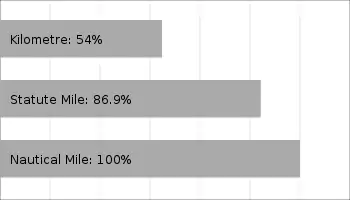Nautical mile
A nautical mile is a unit of measurement used in air, marine, and space navigation,[2] and for the definition of territorial waters.[3] Historically, it was defined as one minute (1/60 of a degree) of latitude along any line of longitude. Today the international nautical mile is defined as exactly 1852 metres (6076 ft; 1.151 mi). The derived unit of speed is the knot, one nautical mile per hour.
| Nautical mile | |
|---|---|
| Unit system | Non-SI unit |
| Unit of | Length |
| Symbol | M, NM, or nmi |
| Conversions | |
| 1 M, NM, or nmi in ... | ... is equal to ... |
| metre | 1852[1] |
| foot | ≈6076 |
| statute mile | ≈1.151 |
| cable | 10 |


Unit symbol
There is no single internationally agreed symbol, with several symbols in use.[1]
- M is used as the abbreviation for the nautical mile by the International Hydrographic Organization.[4]
- NM is used by the International Civil Aviation Organization.[5][6]
- nmi is used by the Institute of Electrical and Electronics Engineers[7] and the United States Government Publishing Office.[8]
- nm is a non-standard abbreviation used in many maritime applications and texts, including US Government Coast Pilots and Sailing Directions.[9]
History
The word mile is from the Latin word for a thousand paces: mille passus. Navigation at sea was done by eye[10] until around 1500 when navigational instruments were developed and cartographers began using a coordinate system with parallels of latitude and meridians of longitude.
By the late 16th century, Englishmen knew that the ratio of distances at sea to degrees were constant along any great circle such as the equator or any meridian, assuming that Earth was a sphere. Robert Hues wrote in 1594 that the distance along a great circle was 60 miles per degree, that is, one nautical mile per arcminute.[11] Edmund Gunter wrote in 1623 that the distance along a great circle was 20 leagues per degree.[11] Thus, Hues explicitly used nautical miles while Gunter did not.
Since the Earth is not a perfect sphere but is an oblate spheroid with slightly flattened poles, a minute of latitude is not constant, but about 1861 metres at the poles and 1843 metres at the Equator.[12] France and other metric countries state that in principle a nautical mile is an arcminute of a meridian at a latitude of 45°, but that is a modern justification for a more mundane calculation that was developed a century earlier. By the mid 19th century France had defined a nautical mile via the original 1791 definition of the metre, one ten-millionth of a quarter meridian.[13][14] Thus 10,000,000 m/90 × 60 = 1851.85 m ≈ 1852 m became the metric length for a nautical mile. France made it legal for the French Navy in 1906, and many metric countries voted to sanction it for international use at the 1929 International Hydrographic Conference.
Both the United States and the United Kingdom used an average arcminute, specifically, a minute of arc of a great circle of a sphere having the same surface area as the Clarke 1866 ellipsoid.[15] The authalic (equal area) radius of the Clarke 1866 ellipsoid is 6,370,997.2 metres (20,902,222 ft).[16] The resulting arcminute is 1853.2480 metres (6080.210 ft). The United States chose five significant digits for its nautical mile, 6080.2 feet, whereas the United Kingdom chose four significant digits for its Admiralty mile, 6080 feet.
In 1929, the international nautical mile was defined by the First International Extraordinary Hydrographic Conference in Monaco as exactly 1,852 metres.[1] The United States did not adopt the international nautical mile until 1954.[17] Britain adopted it in 1970,[18] but legal references to the obsolete unit are now converted to 1853 metres.[19]
Similar definitions
The metre was originally defined as 1⁄10,000,000 of the length of the meridian arc from the North pole to the equator,[lower-alpha 1] thus one kilometre of distance corresponds to one centigrad of latitude. The Earth's circumference is therefore approximately 40,000 km. The equatorial circumference is slightly longer than the polar circumference – the measurement based on this (40,075.017/60×360 = 1855.3 metres) is known as the geographical mile.
Notes
- No meridian was specified in either 1791, 1793, 1795, or 1799. For example, the Law of 18 Germinal an III (April 7, 1795) states: "Meter, the measure of length equal to the ten-millionth part of a terrestrial meridian contained between the north pole and the equator."[20]
References
- Göbel, E.; Mills, I.M.; Wallard, Andrew, eds. (2006). The International System of Units (SI) (PDF) (8th ed.). Paris: Bureau International des Poids et Mesures. p. 127. ISBN 92-822-2213-6. Retrieved 2017-06-20.
- "mile | unit of measurement". Encyclopædia Britannica. Retrieved 2016-06-10.
- "UNITED NATIONS CONVENTION ON THE LAW OF THE SEA". www.un.org. Retrieved 2016-06-10.
- Symboles, Abréviations et Termes utilisés sur les cartes marines [Symbols, Abbreviations and Terms used on Charts] (PDF) (in French and English). 1D (INT1) (6th ed.). Service Hydrographique et Océanographique de la Marine (SHOM). 2016. Archived from the original (PDF) on 2016-08-21. Retrieved 2018-01-04. also available as Symbols and Abbreviations used on ADMIRALTY Paper Charts. NP5011 (6th ed.). United Kingdom Hydrographic Office. 2016. section B, line 45. ISBN 978-0-70-774-1741.
- "WS SIGMET Quick Reference Guide" (PDF). ICAO. ICAO. Retrieved 2016-06-09.
- International Standards and Recommended Practices, Annex 5 to the Convention on International Civil Aviation, “Units of measurement to be Used in Air and Ground Operations”, ICAO, 4th Edition, July 1979.
- "APPENDIX A: SYMBOLS AND PREFIXES". IEEE. Retrieved 2016-06-09.
- "U.S. Government Printing Office Style Manual". U.S. Government Printing Office. Retrieved 2016-06-10.
- Dutton's Navigation and Piloting (14th ed.). Naval Institute Press, Annapolis, MD. 1985. ISBN 0-87021-157-9.
- "Mile, Nautical and Statute – FREE Mile, Nautical and Statute information | Encyclopedia.com: Find Mile, Nautical and Statute research". www.encyclopedia.com. Retrieved 2016-06-10.
- Waters, David W. (1958), The Art of Navigation in England in Elizabethan and Early Stuart Times, p. 374
- McNish, Larry. "RASC Calgary Centre - Latitude and Longitude". The Royal Astronomical Society of Canada. Retrieved 30 August 2019.
- Bureau des Longitudes (1933), "Mesures employées sur les cartes marines", Annuaire pour l'an 1933: 392,
The nautical mile [mille marin] is in principle the length of the sexagesimal minute of a meridian at a latitude of 45°. ... If we assume that the meter is exactly the ten-millionth part of the terrestrial quarter meridian, it would be equal to 1851.85 m. – Translation by Wikipedia.
- Bureau des Longitudes (1848), "Mesures itinéraires", Annuaire pour l'an 1848: 74
- Blazebrook, Richard (1922), A Dictionary of Physics, 1, p. 587
- Snyder, John P. (1987), Map Projections: A Working Manual, p. 16
- Astin, A.V.; Karo, H. Arnold (June 25, 1959). "Refinement of values for the yard and the pound" (PDF). NOAA.gov. National Bureau of Standards. Archived from the original (PDF) on March 9, 2013. Retrieved 2018-07-07.
- "Nautical mile definition and meaning | Collins English Dictionary". Collins Dictionary. Retrieved 1 September 2019.
- "The Units of Measurement Regulations 1995". www.legislation.gov.uk. Retrieved 2016-06-10.
- Hallock, William; Wade, Herbert T. (1906), Outlines of the Evolution of Weights and Measures and the Metric System, p. 54